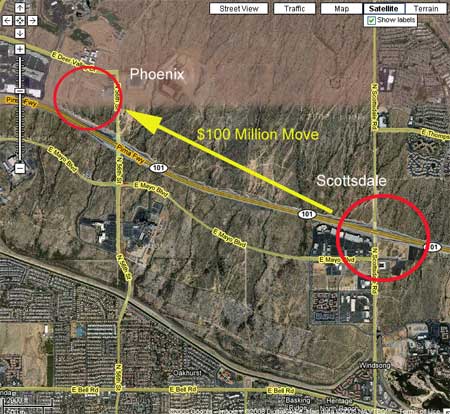If You Had Plans for the Property, You Should Have Bought It
Don't buy property in Paradise Valley (a suburb of Phoenix, near Scottsdale) if you actually expect the property to be fully your own. Even the smallest revisions of your home can require multiple appearances in front of the town council. By some odd statistical anomaly, property owners with friends in the city government seem to get these changes approved more readily than those without such influence.
Anyway, things just get worse if you own a lot of land in PV.
A residents group is preparing to launch a voter referendum against the
planned Ritz-Carlton, Paradise Valley Resort, claiming the project's
residences are too dense....Scottsdale-based Five Star Development wants to build a 225-room resort
hotel, 15 1-acre home sites, 46 luxury detached homes and 100 patio
homes on about 105 acres northwest of Scottsdale Road and Lincoln Drive.
This really isn't very high density, but this can be a very flaky town. One thing you have to realize is that I can't remember the last new home I saw go up in PV that was less than 5000 sq ft and 10,000+ sq ft is not at all unusual. This may be one of the few cases where a town is trying to keep out the Ritz Carlton because its customers will bring down the neighborhood, lol, but that is exactly what is at work here, in part.
Now I know you think I am exaggerating when I say the locals are worried about a Ritz-Carlton bringing down the neighborhood by attracting the unwashed, but here is the Zillow sales page for the area -- the vacant lot in the lower right is the property in question.
This piece of land has been empty and zoned for a resort for years. I know it was zoned for a resort long before this sale because I was stuck in traffic court all day and had nothing to stare at but the town zoning map (don't ever speed when crossing PV). The buyers purchased this land several years ago (I think from the Wrigley family) after ensuring the zoning was solid. If the town's residents wanted something else on the lot, they should have bought it themselves. But it is ever so much cheaper to instead use your political influence to tell other people what they can and can't do with their property.
Another thought: It is nearly an article of faith among libertarians that devolving government to the smallest possible unit enhances freedom. Well, here is an example where it does not. Not state or even city would pass a ballot resolution to change the zoning on one small piece of land. But it is entirely possible this could pass in a town of just a few thousand people.




